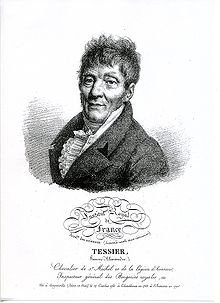Henri-Alexandre Tessier
Henri-Alexandre Tessier (born October 16, 1741 in Angerville , † December 11, 1837 in Paris ) was a French medic, botanist , veterinarian and agronomist . Its official botanical author's abbreviation is " Tessier ".
Life
Tessier came from a modest background and, thanks to a few patrons, was initially able to complete an education at the College Montaigu in Paris, which was intended for clergy. Therefore, before the revolution, he was called Abbé, but was never ordained. He studied medicine in Paris and befriended the botanist Antoine-Laurent de Jussieu . After publishing some Latin treatises, he became a professor at the Faculté de Médecine in Paris (Docteur régent). He was one of the first members of the Société royale de Médecine after it was founded in 1776. He studied an ergot epidemic in Sologne in 1777 and wrote a treatise on it, which in 1783 led to his admission to the Académie des sciences . He also became a member of the Société d'Agriculture de Paris and became director of the royal farm in Rambouillet . There he took care of sheep breeding and introduced the merino sheep to France. He examined seeds from all over the world, cereal diseases and various types of wheat, sheep diseases, the cultivation of cloves and cotton and other current topics in French agriculture.
During the French Revolution, his post became too dangerous and he worked at the military hospital in Fécamp , where he met Georges Cuvier . However, he soon returned to agriculture and became inspector general of sheep farming and was a member of the Bureau d'agriculture. He founded agricultural journals (Journal d´agriculture, Annales de l'Agriculture Françoise) and was editor of the Journal des Savants. Eventually he opened his own farm in Brie , which he managed with modern methods. In order to improve the connection, he built a road with his own resources and he became mayor in gratitude.
In 1802 he married a woman who was half his age and the marriage lasted until his death.
Fonts
- Observations sur plusieurs maladies de bestiaux, telles que la maladie rouge et la maladie du sang, qui attaquent les bêtes à laine, et celles que cause aux bêtes à cornes et aux chevaux la construction vicieuse des étables et des écuries; avec le plan d'une étable, et celui d'une écurie convenable aux chevaux de cavalerie, de fermes, de postes ..., Paris: chez la Ve Hérissant et P. Théophile Barrois jeune, et chez Mme Huzard, 1782 (also translated into German)
- Traité des maladies des grains, Paris, 1783
- Instruction sur les bêtes à laine, et particulièrement sur la race des mérinos, Paris, 1810, 2nd edition 1811
- Instruction sur la manière de cultiver la betterave, Paris, 1811
- Instruction abrégée sur la culture de la betterave, Paris 1812
Web links
- Author entry and list of the described plant names for Henri-Alexandre Tessier at the IPNI
- Information on Henri-Alexandre Tessier in the database of the Bibliothèque nationale de France .
| personal data | |
|---|---|
| SURNAME | Tessier, Henri-Alexandre |
| BRIEF DESCRIPTION | French medic and agronomist |
| DATE OF BIRTH | October 16, 1741 |
| PLACE OF BIRTH | Angerville (Essonne) |
| DATE OF DEATH | December 11, 1837 |
| Place of death | Paris |
